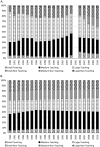National estimates of central line-associated bloodstream infections in critical care patients
- PMID: 23651883
- PMCID: PMC5703042
- DOI: 10.1086/670629
National estimates of central line-associated bloodstream infections in critical care patients
Abstract
OBJECTIVE. Recent studies have demonstrated that central line-associated bloodstream infections (CLABSIs) are preventable through implementation of evidence-based prevention practices. Hospitals have reported CLABSI data to the Centers for Disease Control and Prevention (CDC) since the 1970s, providing an opportunity to characterize the national impact of CLABSIs over time. Our objective was to describe changes in the annual number of CLABSIs in critical care patients in the United States.
Design: Monte Carlo simulation. Setting. U.S. acute care hospitals.
Patients: Nonneonatal critical care patients.
Methods: We obtained administrative data on patient-days for nearly all US hospitals and applied CLABSI rates from the National Nosocomial Infections Surveillance and the National Healthcare Safety Network systems to estimate the annual number of CLABSIs in critical care patients nationally during the period 1990-2010 and the number of CLABSIs prevented since 1990.
Results: We estimated that there were between 462,000 and 636,000 CLABSIs in nonneonatal critical care patients in the United States during 1990-2010. CLABSI rate reductions led to between 104,000 and 198,000 fewer CLABSIs than would have occurred if rates had remained unchanged since 1990. There were 15,000 hospital-onset CLABSIs in nonneonatal critical care patients in 2010; 70% occurred in medium and large teaching hospitals.
Conclusions: Substantial progress has been made in reducing the occurrence of CLABSIs in U.S. critical care patients over the past 2 decades. The concentration of critical care CLABSIs in medium and large teaching hospitals suggests that a targeted approach may be warranted to continue achieving reductions in critical care CLABSIs nationally.
Conflict of interest statement
Figures



Comment in
-
When counting central line infections counts.Infect Control Hosp Epidemiol. 2013 Jun;34(6):555-7. doi: 10.1086/670630. Epub 2013 Apr 18. Infect Control Hosp Epidemiol. 2013. PMID: 23651884 No abstract available.
References
-
- National Nosocomial Infections Surveillance system. National Nosocomial Infections Surveillance (NNIS) system report, data summary from January 1992 through June 2004, issued October 2004. Am J Infect Control. 2004;32(8):470–485. - PubMed
-
- Dudeck MA, Horan TC, Peterson KD, et al. National Healthcare Safety Network (NHSN) report, data summary for 2009, device-associated module. Am J Infect Control. 2011;39(5):349–367. - PubMed
-
- Centers for Disease Control and Prevention. First State-Specific Healthcare-Associated Infections Summary Data Report: CDC’s National Healthcare Safety Network (NHSN), January–June, 2009. http://www.cdc.gov/hai/pdfs/stateplans/SIR_05_25_2010.pdf. Published 2010. Accessed February 23, 2012.
-
- Department of Health and Human Services. Action Plan to Prevent Healthcare-Associated Infections: Incentives and Oversight. http://www.hhs.gov/ash/initiatives/hai/actionplan/hhs_hai_action_plan_fi.... Published 2009. Accessed February 23, 2012.
-
- National Conference of State Legislatures. Hospital-acquired infection legislation database. http://www.ncsl.org/issues-research/health/hospital-acquired-infection-l.... Accessed February 23, 2012.
MeSH terms
Grants and funding
LinkOut - more resources
Full Text Sources
Other Literature Sources
Medical
Miscellaneous
